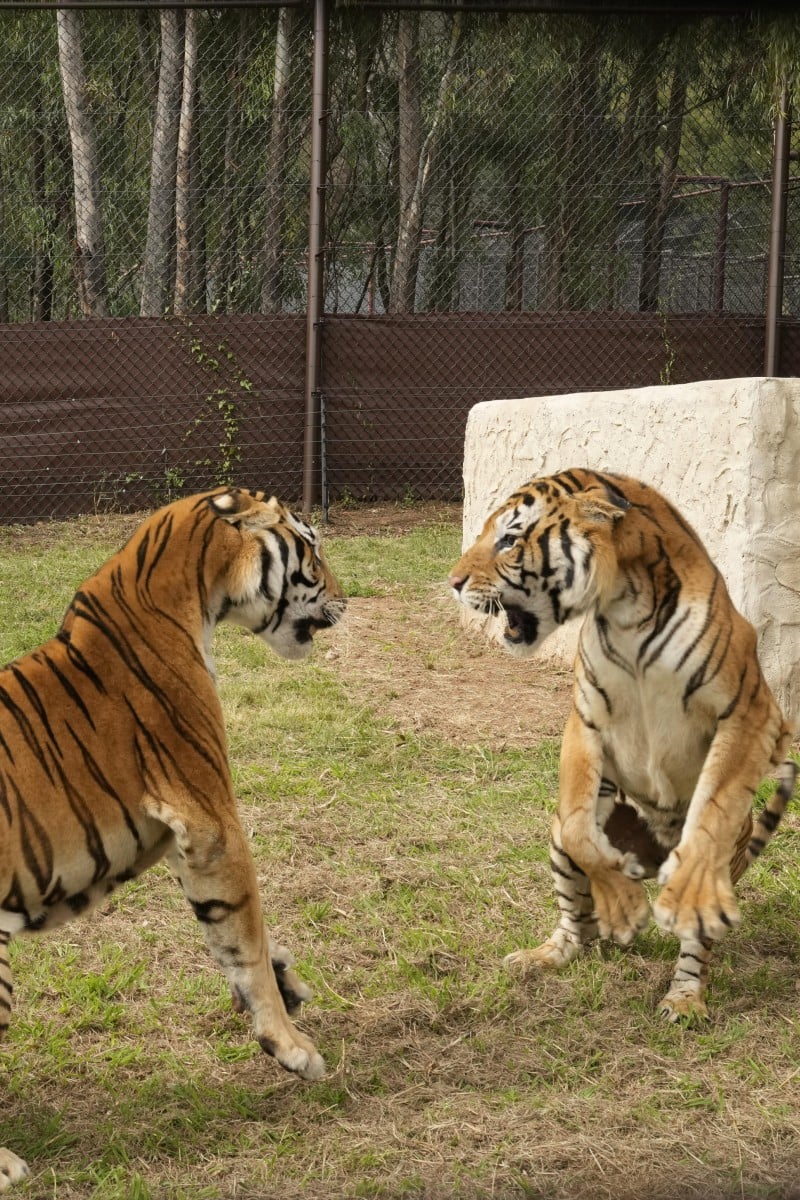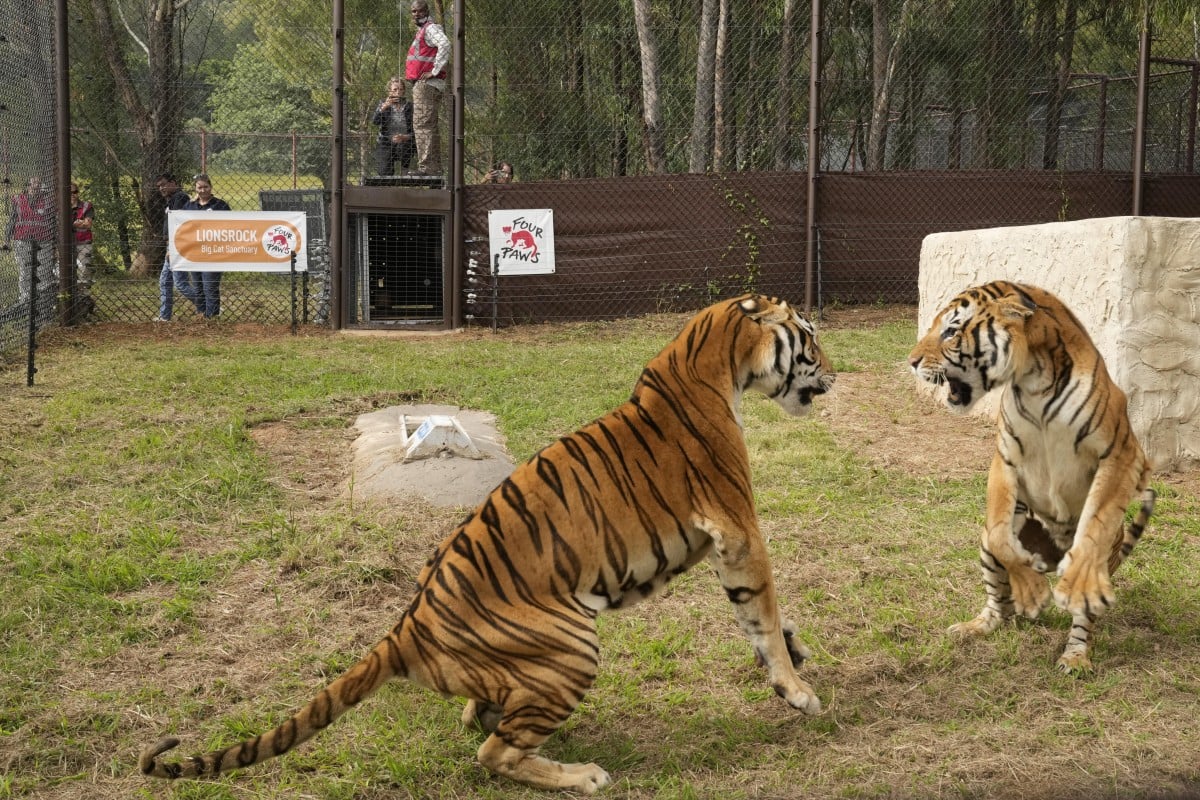
5-minute listening: Bengal tigers rescued from captivity get new home in sanctuary in South Africa
- Practise your English with our short listening exercises: play the audio linked below; answer the questions; and check the answers at the bottom of the page
- This week’s podcast features four Bengal tigers who finally get a new life in a sanctuary in South Africa after they are rescued from being prisoners on a train
 Two tigers play in an open-air enclosure at the Lionsrock Big Cat Sanctuary in South Africa. Photo: AP
Two tigers play in an open-air enclosure at the Lionsrock Big Cat Sanctuary in South Africa. Photo: APClick on the video below for the audio (the script has been adapted from Associated Press).
Play a Kahoot! game about this podcast as a class or with your friends by clicking on the link here.
Or play on your own below to test your understanding:
Questions
1. Where were the Bengal tigers kept before they arrived in South Africa?
A. India
B. Kenya
C. Argentina
D. Pakistan
2. What does it mean if an animal is held in “captivity”?
A. It is captured from the wild.
B. It is not treated very well.
C. It is not allowed to leave.
D. It is used to interacting with people.
3. How long did the tigers travel to get to Lionsrock Big Cat Sanctuary?
A. a few hours
B. half a day
C. two days
D. more than 50 hours
4. Which of the following animals can one expect to find in Lionsrock Big Cat Sanctuary?
A. lion, tiger, leopard
B. wallaby, koala, wombat
C. hamster, guinea pig, gerbil
D. wolf, hound dog, fox
5. When you “survey” something, you …
A. take a quick look at it
B. give a description of its appearance
C. conduct an experiment on it
D. examine it carefully
6. What was the tigers’ first meal at the Lionsrock Big Cat Sanctuary?
A. a special type of cat food
B. chunks of meat
C. an entire wild boar
D. information not given
7. How do you feel about someone’s arrival if you give them a “welcome treat”?
A. unconcerned
B. apprehensive
C. excited
D. spiteful
8. What animal welfare organisation does Dr Amir Khalil represent?
A. Lionsrock Big Cat Sanctuary
B. Lionsrock Reserve
C. Big Cat Rescue
D. Four Paws
9. How many tigers are kept in each enclosure?
A. one
B. two
C. three
D. four
10. How long will the tigers be in their open-air enclosures?
A. a fortnight
B. five weeks
C. eight months
D. information not given
11. Where will the tigers be moved to next?
A. larger enclosures within Lionsrock Big Cat Sanctuary
B. another sanctuary in South Africa
C. the largest zoo in South Africa
D. back into the wild
12. How many big cats are currently living in Lionsrock according to the podcast?
A. less than 30
B. between 50 and 80
C. more than 100
D. close to 1,000
13. What do “the elements” refer to in the podcast?
A. climate change
B. bad weather
C. earth, air, fire and water
D. harmful chemicals
14. Why are the enclosures designed to be circular in shape?
A. to make it easier for the cats to find their way
B. so that the cats do not feel they are in a corner
C. to prevent the cats from escaping
D. to allow better access for the sanctuary’s staff
15. Where are the animals at Lionsrock Big Cat Sanctuary rescued from?
A. zoos
B. circuses
C. private homes
D. all of the above
Answers
1. C
2. C
3. D
4. A
5. D
6. B
7. C
8. D
9. B
10. D
11. A
12. C
13. B
14. B
15. D
Script
Voice 1: Four Bengal tigers rescued from years of captivity in a train carriage in Argentina were released into open-air enclosures in South Africa earlier this month.
Voice 2: After a journey of more than 70 hours from Argentina, the tigers stepped from their crates into open-air enclosures at the Lionsrock Big Cat Sanctuary in South Africa’s central Free State province.
Voice 1: Visibly curious about their new homes, the tigers surveyed the boundaries of their fenced-in areas, about 80 square metres in size, and chowed on chunks of meat put out as a welcome treat.
Voice 2: The tigers’ arrival in South Africa was the culmination of years of planning by international animal welfare organisation Four Paws, said Dr Amir Khalil, who is the mission leader and veterinary surgeon of the NGO.
Voice 1: The tigers are currently kept as pairs in two separate enclosures. Over the next weeks and months, the tigers will be monitored and get any necessary veterinary care. The next step will be to release the tigers to bigger enclosures that are several acres large, and where more than 100 big cats, such as lions, leopards and tigers, are living.
Voice 2: All the enclosures include open grassland with bushes and trees, as well as protected natural areas where the animals can rest and shelter from the elements. The enclosures are circular in shape and follow the natural shape of the land so that the cats do not feel they are in a corner.
Voice 1: The animals have been rescued from circuses, zoos, the entertainment industry and private captivity from all over the world including Bulgaria, Germany, Switzerland and the United Kingdom. Four Paws has established the Lionsrock reserve in South Africa for the big cats. Visitors can come to see the animals in their new environments.
